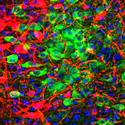Featured Paper of the Month – March 2024
Published in Biological Psychiatry by Xiang Xiao and Yihong Yang, et al. of the NIDA IRP Magnetic Resonance Imaging and Spectroscopy Section.
Cognitive function and general psychopathology are two important classes of human behavior dimensions that are individually related to mental disorders across diagnostic categories. However, whether these two transdiagnostic dimensions are linked to common or distinct brain networks that convey resilience or risk for the development of psychiatric disorders remains unclear.










